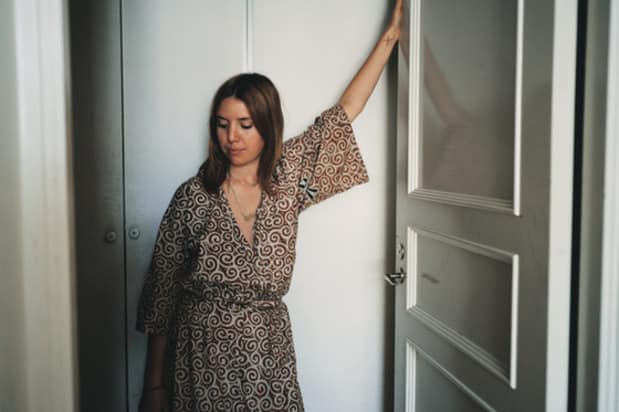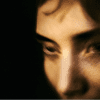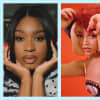Lykke Li's new video for "Breaking It Up" wisely focuses on her ill accessorizing and marionette-ish dance moves — two attributes which first drew us to her, along with, of course, her excellent music. We were so sure about her allure that we gave her a feature story in our Aaliyah Icon issue, and now you can read it in its entirety after the jump. And make sure to check out Lykke live as she tours Europe and North America this summer and fall.
Story T Cole Rachel
Photography Emma Hardy
Lykke Li is not in love with anyone at the moment and, apparently, this is a big problem. Having already spent two days hanging out with Li in Stockholm, the diminutive, strawberry-haired singer remains somewhat inscrutable. When I ask about the link between romantic love and making good pop music, she becomes more animated than I’ve seen her all day. “Why are people so obsessed with relationships?” she asks. “That makes me insane. My girlfriends never ask me how my shows have been going or about my music, they only want to know if I’ve hooked up with anyone cute. The romance part just fucks everything up and complicates stuff.” After a long pause, she laughs and says, “Still, I’m gonna need to fall in love soon and have my heart broken, otherwise I’ll never make another record.”
Li’s first album, Youth Novels, is not only the product of heartbreak, it is also the end result of one international love affair, several years of hard work and the ambitious drive of its creator. Recorded in Stockholm and New York, and set for US release this summer, the album is a deceptively simple confection of dance beats, quirky instrumentation and Li’s breathy vocals. What sets the record apart has less to do with the sparkly production than Li’s lyrical sensibility. Songs like “Little Bit,” with it’s infamous For you I keep my legs apart/ Don’t think about my tainted heart line, wrap dark sentiments in smooth, mass consumption-ready packages.
Such contradictory notions are at the heart of what makes Lykke Li such a magnetic figure in the rotating roster of Swedish musical exports. She is both bold (“I want to be like Patti Smith, Madonna and Edith Piaf all combined into one human.”) and quietly self-depricating (“I’m not an artist and I don’t know how to sit down and write a complete song.”). She just may be the perfect barometer of what makes the chic style, quirky artistic sensibility and perfect hooks of Swedish indie pop so fascinating. It’s easy to forget that she’s only 22 years old.

The story of Swedish pop music truly began in 1972, when ABBA came to symbolize what a powerful cultural export it could be. All Swedish phenomenons—from Roxette to Ace of Base to the Cardigans—have existed in the shadow of those blonde and bearded behemoths. This decade alone has provided the Hives, the Knife, Love is All, Jens Lekman, Robyn, Jose Gonzalez and the Shout Out Louds among others. Additionally, Swedes—in the form of über-producers Max Martin and Bloodshy & Avant—have penned some of the most globally ubiquitous and indelible pop songs of the last ten years, including Kelly Clarkson’s “Since U Been Gone,” Britney Spears’ “Toxic” and the Backstreet Boys’ “I Want it That Way.” In response, foreign journalists tirelessly revisit the old “there must be something in the water” story in an effort to describe how such a relatively small Scandinavian country has produced such a large amount of compelling, Americanized music. And while it’s pointless to generalize the musical output of entire country, there is something to be said for the argument. Maybe there is something in the water.
For the past 14 years Nina Persson of the Cardigans has fielded the same questions regarding Swedish music, allowing her lots of time to think about the subject. “Sweden is a very small country and I think Swedes are used to looking outside of our own borders for inspiration,” she says. “We are also great collectors—whether it is art or music or design. We have a knack for taking the best elements of things and making them our own. I mean, Swedish people are often really hip, you know? It can get a little annoying to be in Stockholm. It’s like a competition to see who can be the most current, the most informed, the most cutting edge. Also, our definition of ‘pop’ music has always been a little different than a lot of other people’s. Weirder, perhaps.”
According to Robyn, another Swedish artist that’s currently huge in Sweden and hip in America, the tradition of Swedish pop music is not so much about a particular aesthetic, but an attitude. “We don’t tend to think of pop music as something different, or lesser, than, say, rock music or hip-hop,” she says. “Somehow pop music got a bad reputation in a lot of the world. I don’t think Swedish musicians tend to look at it that way. We have a lot of respect for the notion of pop.”
On a quiet street in the Sodermalm area of Stockholm is the two-bedroom apartment that Lykke Li shares with her 19-year-old brother, Zacharias. “He goes to art school,” she says, “which means he mostly smokes weed and hangs out and lives like a pig.” While her brother’s room is deemed off limits, Li’s bedroom is remarkably sparse—a bed, a chair, some simple recording equipment, a piano (with a copy of Prince’s Lovesexy nakedly propped against the keyboard) and a suitcase full of clothes. “I never really unpack completely,” she says. “I just live out of that.”
The children of Swedish hippies, Li (born Lykke Li Timotei Zachrisson) and her siblings spent their childhoods moving between Stockholm and a small mountain village in Portugal where her parents now live full-time. Her father, Johan Zachrisson, is a jazz musician who played in popular Swedish band Dag Vag. Her mother, Kersti Stiege, was a founding member of Tant Strul (Sweden’s first all-girl punk group) before going on to make a name for herself as a photographer. Li also has two adopted sisters from Tibet, Pema and Karma, who are now in their 30s. As Li remembers it, her childhood was full of travel and creativity and very few rules. Summers were often spent on photography expeditions throughout India with her mother where the kids “ate all kinds of crazy street food and ran around wild” or served as models in their mom’s assignments. Li pulls out old albums filled with her mother’s work: carefully staged portraits taken in remote areas of India, an ’80s magazine story featuring a tiny Lykke Li carefully making a pizza in a roughly hewn kitchen, and, even more surprisingly, an amazing array of photographs taken in late-’70s New York City. “My parents were pretty cool,” Li says. “They were right in the middle of everything.” She directs me to a framed black and white photo hanging in the kitchen. It’s a candid shot of Li’s father casually smoking a cigarette while standing next to Andy Warhol at Studio 54, taken by her mother.
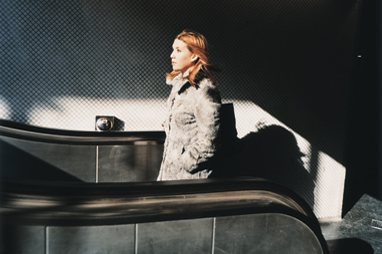
“It was hard to be rebellious with parents like mine,” Li says. “My sister Zara was the bad one. Since my parents were such hippies, she got back at them by spending money on expensive clothes or telling my mom that she was going to have cosmetic surgery. I always felt like I needed something to push against, but it took me a long time to figure out what I wanted to be.”
The birth of Lykke Li the musician took place not in Portugal, India or Stockholm, but in New York City. As a kid, Li had mostly been interested in dance, but like so many other artists of her generation, it was the late discovery of Michael Jackson and a love for Madonna that ultimately captured her imagination. Having finished up school in 2005 and desperate to get as far away from Stockholm as possible, Li saved up money from waitressing and booked a ticket to New York. With no real friends in the city and only a handful of contacts, she rented a windowless room in Bushwick, Brooklyn and set about making it as a musician. “That place was so terrible—giant roaches, rats and basically no heat at all,” she remembers. “I would go to bed wearing my coat, seeing my breath puff in the air. And still I was so happy.” She started booking spots at open mic nights (“It was always me and about 10 guys trying to look like Bob Dylan,” she says) and managed to get a show at Pianos by convincing the management that she was a famous singer from Stockholm. “I got all dressed up and went there—fur coat, big sunglasses, looking very cool. Another band had cancelled and they offered to let me play in the main room downstairs. Since I had no guitarist and only about five songs, I was just like, ‘Oh, no. I’d rather do something intimate for my friends. I’ll play upstairs instead.’ I couldn’t believe they were agreeing to it.” Not long after, Li’s New York story ended the way so many do: her visa expired.
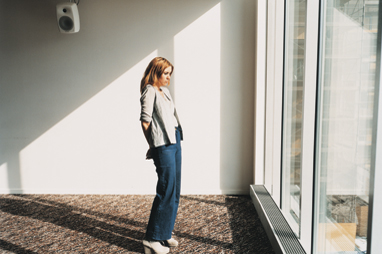
But before she left the city, she had both the dysfunctional romance at the heart of Youth Novels and the realization she had to get serious about her career. Li’s success in Sweden would prove both swift and strange. After formulating a demo and basically bumrushing various record label offices (“I told them I was big in New York, I’d played at Joe’s Pub!”), Li was linked up with Bjorn Yttling, producer and member of Peter Bjorn and John. “I think I overwhelmed him a little,” she says. “I’m like jumping around talking about how I love hip-hop and Patti Smith and how I’m gonna be the illest. He gave in eventually, because I was so weird and funny.” The now-standard process followed: a few songs were posted on MySpace, blog posts were written and eventually Lykke created her own label, LL Recordings, and released the Little Bit EP. In the meantime, she worked a variety of odd jobs (including a stint at a nursing home) and waited impatiently for Yttling to come home from touring and help her properly finish her album. “Finally,” says Li, “I was just like, ‘Bjorn, I’m like the hot shit right now in Stockholm, so we need to get moving on this!’” With an original vision that Yttling describes as “Karen Dalton fooling around with Dr John,” Youth Novels zooms off in a million different directions. Few restrictions were applied and any instruments that happened to be lying around the studio eventually found their way into the songs.
The current attention for the resulting record has, if nothing else, helped quell the restlessness and tedium that plagued Li during the making of it. At least a little. “I know I complain sometimes, but I love my life,” she says. “I realize that you don’t need to have someone in order to be happy. I used to weep over the fact that I wasn’t doing music. Now that I’m doing music there’s that part of me that is dying to be in love. I keep reminding myself that it’s possible to have both, and if you don’t, it’s not the end of the world.”
This almost teenage sense of excitement and melodrama is, in many ways, what makes Lykke Li so charming. On stage she exudes an unshakable charisma—sexy but not exactly sexual. Both in person and as a performer, she strikes a curious balance of naiveté and worldliness. “It’s very hard not to like her,” says Adam Olenius, lead singer for the Shout Out Louds, whose last album Li sang on. “She’s very much like our little sister—annoying at times, but impossible to ignore. As it turns out, she’s the one who could go on to be the biggest star.”
The thing that makes Li such an inspired pop presence is perhaps her reticence about being one. Her music, her personal style and her vision for what it means to be an artist are all unabashedly kaleidoscopic. “I would never want to think of myself as simply a pop singer,” she says, “even if that’s how my music comes out.” Sitting in Yttling’s studio, surrounded by all manner of futuristic, music-realizing audio equipment, Li is absolutely serious when she claims that her goal is to simply “make everything, every kind of sound possible.” Her music springs from her most intimate and uncalculated self. And like the best Swedish pop, her songs take conventional forms and change them into something entirely personal, decidedly forward-thinking and perfectly accessible. In that way, she fits into a national tradition of turning something universally banal into a wonderful bit of art, even if she thinks she is stepping away from that tradition.
In Sweden, a weird bit of evidence of Lykke Li’s new notoriety is that her video for “Little Bit” has inspired the “Lykke bun,” a popular hairstyle copied by many young girls. “One magazine actually asked to do a story where I showed them how to make the perfect bun. As a result, I never wore my hair that way again,” says Li. “Now I don’t know what to do with my hair.”
